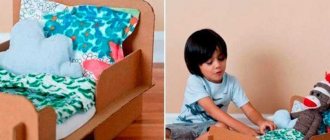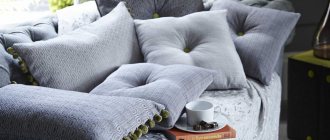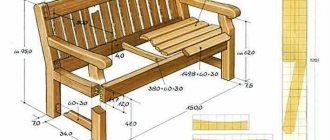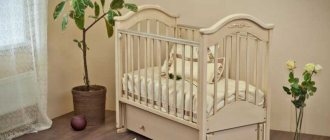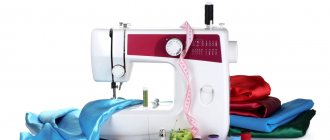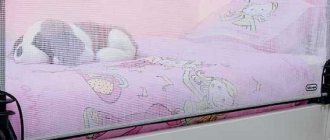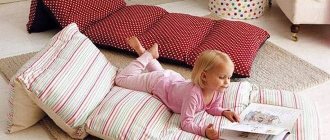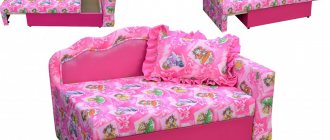You can buy bumpers for your baby's crib at any children's store. This accessory became popular back in the Soviet years and has not lost its relevance to this day. At the same time, making bumpers for a baby crib with your own hands is not so difficult. The main thing is the desire of the parents themselves to decorate the space of the cradle. The stores have enough materials for sewing and decorating such products.
The article shows how to sew bumpers for a child, what models you can choose and how to decorate. The accessory is not only attractive, but also practical. It prevents the baby from getting injured and adds comfort to the interior.
DIY bumpers for a baby crib
Side functions
The frame of children's beds made of metal and wood is quite rigid. The side parts often consist of beams. Light enters through the holes in the crib. A small hand or foot of a newborn can get there, which also adds to the concern of young parents. The solution in both cases is to protect the sides of the cradle. A special bumper with filler acts as a limiter and becomes a buffer between the baby’s cozy world and the outside environment.
An additional function of the sides is educational. You can place interesting pictures on them, add educational motifs to decorative elements, and equip baby accessories with squeakers, rustling sounds, moving and musical parts.
Star pillow attracts baby's attention
When choosing a crib, it is recommended to take into account several factors: the practicality and safety of the material and design, the appearance and functionality of the product. Modern manufacturers offer a wide range of models to suit every taste and budget. The round crib has become especially popular lately.
How to make a fall protection bed with your own hands
You can easily make a do-it-yourself limiter for a children's bed of any kind at home, both from scrap materials and from inexpensive building materials, despite the fact that this attribute will serve as long and reliably as the factory one.
If the built-in limiter is a series of vertical slats, then the arms and legs of babies can get stuck between them. In this case, a soft border is also necessary.
How to make a bed restrainer from wood with your own hands
First, you need to decide on the method of attaching the limiter; the easiest way is to attach it to the side of the bed, but this may not be a very aesthetic way and will damage the structure of the crib. You can choose any convenient one from the list of mounts listed above.
For older children, who are around the age of three, you can choose low restraints to prevent them from falling while sleeping.
Decide on the future design and shape of the holder. Prepare the necessary material and tools, namely:
- Reliable wooden bars;
- Hacksaw;
- Self-tapping screws and/or bolts;
- Screwdriver;
- Ruler or tape measure;
- Paper and pencil.
To make the simplest U-shaped barrier, which will be fastened with bolts, you will need slats 55 cm long; the height is selected individually, can be from 15 to 30 cm.
For a crib measuring 70x120 cm, a side with a height of 70 cm will be optimal.
Step-by-step description of the side manufacturing process:
- Draw a schematic diagram of the proposed barrier for the crib, taking into account future dimensions;
- Cut the wooden slats according to the dimensions indicated in the diagram;
- Carefully fasten the bars together to ultimately obtain a U-shaped frame.
- Drill holes for fastening bolts on the installed barrier and the side of the bed;
- Screw the limiter to the bed using bolts.
Additional Information! Instead of blocks of wood, you can take a single piece of board and attach the required size to the bed, this will prevent the child's body or body parts from getting stuck in the resulting gap.
Older children need curbs to prevent them from falling while sleeping.
How to make a bed restrainer with your own hands from other materials
Side made of material
To do this you need:
- Take measurements of the crib;
- Construct a rough plan of the building on paper;
- Purchase foam rubber or padding polyester, fabric for the cover and fasteners in the required quantity;
- Roll up rolls of material and stitch;
- Sew covers of a suitable size;
- Sew fasteners onto the covers and mattress;
- Attach the restraint to the bed.
The color scheme of the bed limiter, as well as the bed itself, depends entirely on the flight of your imagination.
Plastic side
Pipes purchased from the plumbing department of a hardware store work well here. They are easy to fasten together, the fastenings are strong, and the whole structure is quite simple.
The holder can be attached to the side of the bed, to the bottom of the bed, or under the mattress, if the age and weight of the child allows.
Removable restraints are installed, as a rule, only on part of the bed, and therefore are suitable for older children - approximately three years of age and older.
Mesh side
- Measure the bed;
- Plan the approximate size and design of the limiter;
- Purchase materials: strong mesh, slats made of wood, metal.
- Cut and fasten the frame from the slats;
- Attach the mesh in the middle;
- Cover the frame with a suitable fabric or thoroughly sand the surface of the wood and varnish it, let it dry.
- Attach to the bed in any convenient way.
Parents traditionally prefer pink for a girl and blue for a boy.
Important! Check the surface of the homemade border for the presence of piercing and cutting edges and immediately eliminate it so as not to damage the integrity of the child’s skin.
Side for newborns
How to make a side for a children's bed so that the child does not fall? Restraints on newborn cribs are necessary not only to prevent children from falling, but also to soften the hard parts of the bed.
This function can be performed by soft woven bolsters and pillows placed around the perimeter of the crib and covering sharp corners.
In cribs designed for newborns, restraints are installed along the entire length, safely limiting the space of the crib.
Natural hypoallergenic materials are suitable for making barriers. It is not advisable to use hard parts to decorate the sides, because they can scratch the delicate skin of babies, or get into the respiratory tract and cause suffocation.
For the little ones, soft models of bumpers are available. They can cover the crib on four sides, or they can only be attached to two long sides.
Child's age and bumper type
Ideas for arranging the internal contents of a crib are determined based on the needs of the child.
Protection in the form of sides can be full or partial. The first covers all sides of the crib, the second protects the child on the right and left. The age of the baby in this case is the main indicator affecting the density of the structure.
Pillows for sides, which can later be used in the nursery
Solid sides are ideal for active babies who explore the world and are able to move around the perimeter of the bed, but are not suitable for a newborn who wants to explore what is happening around them.
White bumper for crib
The white crib bumper is suitable for both boys and girls. Many people refuse white because the color is easily soiled and impractical. But if you wash the sides often, the crib will always look neat and cozy.
You can buy white bumpers with different patterns. Choose the fabric that you like best.
White bumpers for the crib Bumper with stars White bumper for the crib
For deer lovers, the following set is suitable. This set is more suitable for a girl.
White bumper with deer
For a boy's crib, light-colored checkered borders are perfect.
White checkered bumper
Which models are suitable for home sewing?
There are removable sides for the crib, which are mounted in the form of a dense rectangular piece on the side. The work requires reliable material, which is not always easy to find. In addition, it is worth taking care of fixation - this may require complex structural elements or rare fittings
In general, vertical removable parts for sidewalls are more convenient, but they are not so easy to make at home.
Borders for a newborn's crib
Non-removable sides are ideal for DIY sewing. They are either placed in the crib as an insert, or tied to it with ribbons, fastened with buttons, etc. Sewing a non-removable buffer is easier, since it is based on a filler and a cover. Such models are universal and do not require special materials, complex tools or skills. They can be decorated to your taste. A huge selection of fabrics and decorative elements, the ability to use several types of covers for the interior - all this gives room for imagination and creates a unique, inimitable atmosphere in the nursery.
Sewing bumpers for a baby crib is usually not difficult. They do not require intricate cutting. The parts are cut out according to the standard, or based on the dimensions of the crib, if its dimensions are far from those presented in the store.
Types of fixed sides
Protective soft fencing can be classified into several categories. The choice is strictly individual. At the same time, there are many types of fences with filler.
According to the degree of density, crib restraints are:
1. Solid - such bumpers are presented in the form of fabric stretched around the entire perimeter, or in the form of similar parts with a soft filler.
Solid side for crib
2. Composite - a bumper in this category consists of interconnected parts (they can also be of varying degrees of softness), the advantage of which is their multifunctionality (pillows, for example, can be used not only as part of the bumper, but also for their intended purpose).
Depending on the presence of additional elements, there are simple crib guards and decorated ones. For a small child, it is advisable to think through the decorative component so that the side serves not only as an element of safety, but also develops the baby’s visual reactions.
The limiter may have a bottom. It can also consist solely of sidewalls. It is advisable to make the choice of one design or another based on the temperature conditions in the room. If the apartment or house is quite cold, a dense base filled with insulation will be a good choice. The side parts of the side will be attached to it.
Soft side without bottom
The bumper, which is sewn to a dense base, allows less air flow for the child, but in the warm season and hot heating season this can negatively affect his well-being. In addition, a fence that is too dense can interfere with the child's ability to explore the world, completely obstructing his view.
Before cutting, it is necessary to take into account the configuration of the bumper that is supposed to be used:
3. Pillow sides - can be with or without removable covers; The main requirement for pillows is the absence of small parts in fasteners and other elements that the baby can accidentally pull into his mouth and swallow.
Pillow sides can be found both in standard beds and in extension beds. In the latter case, cutting and sewing are carried out with less material consumption.
Traditional cushion design
4. High soft barriers - the design blocks the view, despite the good protection of the baby from impacts and falls.
High bonbon sides
5. Low-height sides are the complete opposite of the previous option; they require a more attentive attitude to the safety of the child.
An alternative to the previous option is a low side
6. Bumper with pockets - the internal filling will always attract attention, so this configuration will educate and develop the little inhabitant of the crib, but at the same time it can overstimulate.
7. Fences in the form of rollers - this option can be used as an alternative to pillows.
Side bed rails in the form of pillows
Prices for sides for the arena
Playpen protection
Types of bumpers for a crib
There is a huge variety of models of these products to ensure a comfortable time for your baby in his own bed. And if you make the sides yourself, then you can show any imagination in terms of shapes, sizes and placement principles.
The following types of soft limiters can be roughly defined:
- Functionality. With or without removable covers. With pockets on covers or plain satin stitch.
- Versatility. Side pillows. These can be decorative pillows or cushions.
- Shape: rectangular, rounded, round, square.
- Multicomponent. The design can consist of a minimum of 4 parts and there is no maximum.
- Uniqueness. Unusual interpretations - little animals, houses, caterpillars and much more.
Option for sides for a crib
Sometimes several options can form 1 set, which will make it even more convenient to use.
You might be interested in this: Creating patterns and sewing backpacks according to instructions
Bumper fillers
If you have decided to use soft parts in the design of the guard, you should think about the inside and choose one of the following types of natural or artificial fillers:
Table 1. How to fill the crib restraints
| Natural ingredients | Artificial materials |
|
|
Features of fillers
An interesting idea is to use not only soft fabrics, but also dry herbs as filling.
Table 2. Impact of aromas on a child
| Herbs | Impact on well-being |
| Lavender | Normalizes the functioning of the nervous system, gives peace, improves sleep, eliminates excessive emotionality and tearfulness |
| Fennel | Eliminates anxiety, relieves abdominal cramps |
| Bergamot | Treats anxiety, helps fight viruses, is good for skin with rashes |
| Hop | Calms, improves sleep |
| Rose | Stabilizes the nervous system, improves immune function |
| Chamomile | Relieves pain, spasms, antiviral |
You can use the above herbs in their pure form and in various proportions. As a result, the child will sleep better, be capricious and get sick less.
Herbs in a case - pleasant aroma and benefits for the body
Materials for the outer part of the bumper
To ensure that the covers are well ventilated, they can be made of linen or thick calico.
The main requirement is that the threads of the woven material must be tightly intertwined, securely connecting to each other and creating a barely noticeable relief. A fabric that is too smooth will be uncomfortable for the child.
In general, it should be said that choosing fabric for children's clothes is a responsible matter. Any specially processed cotton is used to sew covers. But not every cotton fabric is suitable for sewing an accessory for a crib. Chintz, for example, leaves lint that can cause allergic reactions. Canvas has a similar disadvantage. Moreover, it is too tough.
Satin may be too slippery. If you use elements of denim when sewing protective sides, they may turn out to be rough for the delicate skin of the child’s hands and feet.
Different types of fabrics for sewing
The outer parts of the sides can be made of anything. But you should avoid silk, satin and 100% synthetics. Compared to cotton, these materials offer a lot of stretch. The outer part of crepe-satin can be stitched with propylene - this prevents unraveling. It is also better not to use allergenic wool for the outside of the bumper.
Sides made of crepe-satin are the outer part, which can serve as decoration when the child is awake
Before cutting any model, the fabric should be washed and ironed.
The color of the material is also an important element. The general rule is that shades should be dim and unsaturated. Warm or neutral colors are preferable. This is due to the color perception that is available to the baby.
A successful and moderately contrasting combination of colors in a crib
Due to his age, he is able to accept not all visual images well, but only certain tones of the picture.
The dominance of one color in the side of the crib, as well as the presence of too bright color spots in the decoration, which overload the fragile psyche, is wrong. As a rule, certain color combinations that should not be used are perceived as too catchy.
Unacceptable color combinations for baby bed bumper
Photo of do-it-yourself crib bumpers
Read here - Do-it-yourself furniture remodeling: original and beautiful methods of furniture restoration (115 photos and videos)
Help the site, repost 
0
Attachments for child side boards
The sides can be attached to the crib using ties or Velcro. For fastenings, you should not choose smooth ribbons - for example, satin. They can easily fall off, in which case the child may be injured.
Separately, you should consider the features of the ties - any other method of placing the sides in the crib is more difficult to implement, and its elements can, moreover, harm the child.
Short sewn ties are only suitable if they are made on pillows. By connecting such elements in pairs, you don’t have to worry about the collapse of the structure. A reliable option are flip-over ties that need to be sewn in. Reversible fastenings can be additionally equipped with Velcro.
It is better to decide on the fastening method in advance - the sewing pattern depends on this
How to calculate the number of products and their sizes
There are recommendations regarding determining the parameter for 1 element depending on the type of soft fencing structure. This makes calculations and presentations easier for beginning needlewomen.
How to make calculations and make a choice:
- If the fence consists of pillows, then you need to make 2 pillows on the headboard and a symmetrical part of the bed. There can be 4-5 pillows on the sides.
- Classic sides consist of only 4 parts, so it is important to know only the length and width of the sides of the crib.
- If you make shaped products, then focus on the quantity and parameters on pillows.
You might be interested in this: Simple patterns and instructions for sewing men's jackets
Size according to diagram
Much depends on the shape and dimensions of the sleeping place and crib. Therefore, you first need to take measurements, and only then ask the price for the quantity and size of each element of the soft furnishings. Take measurements from the crib. You need to write down the height, length and width parameters of each piece.
Decorating the sides
In order to give the sides that protect the child from injury an attractive look and create a truly original product, you can use many finishing options.
Soft parts are decorated with felt appliqués or cotton fabric stripes.
It is important that the decorative elements are securely sewn to the base. Otherwise, the child may tear them off and harm himself.
You can make your own patches or purchase ready-made ones.
One of the decorative options is special stickers, which are sold in hardware departments or furniture stores. They do not leave sticky marks on the surface and can be successfully used on fabric bases.
Adhesive-based applications have similar functions. The only difference is that they cannot be removed easily. But there is also a plus - the adhesive applications are securely fixed to the fabric of the protective sides.
We must remember that a baby’s bed is not a place for small rhinestones, beads and other elements that can be easily detached.
Adhesive parts adhere firmly to the fabric base
When decorating children's things, you can use any ideas. The main thing to consider is the degree of security of a particular element.
Side bolster for a child's crib
If the mother does not want to block the baby’s view and lay out foam pillows over the entire area of the bed, you can sew small bumpers.
It is very simple to sew such products - you need to make a blank from several flat pillows, or sew one large one. If the latter option is chosen, the pillow is stitched in the center so that “pads” are formed.
Do-it-yourself side braid for the crib
You can make not a double, but a triple braid, or sew several braids together in order to get a continuous fabric and hang it on the back wall of the crib.
The pigtail option is ideal for round beds - it is simply laid out from below and prevents the child from hitting his arms, legs and head in his sleep. When sewing braids, it is important to securely fasten all the transitions so that they do not fray during washing.
Making your own fabric borders
The most common side configurations are:
- solid model;
- pillow version;
- “sausage” sides made from rollers.
Sewing a continuous border
To make a protective board with tape fastenings, you will need the following materials and sewing supplies:
- calico;
- padding polyester;
- pins;
- ribbons to match.
To connect the parts you need a sewing machine and an iron. You will also need scissors during the manufacturing process.
Consider the option of sewing for one side of the bed. In a similar way, you can make sides for the remaining parts of the perimeter.
Such sides breathe well (if compared with a continuous liner throughout the entire perimeter, sewn to a dense bottom). In addition, they perfectly protect the baby and are securely fixed with tapes.
Step 1. You need to cut out two rectangles of calico and a filler of the same size
Step 2. Cotton is folded right sides together
Step 3. Place a filler piece on the calico
Step 4. Cut the ribbons and fold them in two layers
Prices for round cutting knife
Circular knife 45 mm cutting for fabric
Step 5. Pin the ribbons for sewing
Step 6. We sew all the details
Step 7. Preparing the side for the final stage
Step 8. Sew up the hole, iron
Step 9. Attach the finished side to the sidewall. From this moment on, the baby is protected from sudden injury on the side where there is a protective fence
Instructions for sewing children's bumpers - cat pillows
Pillow bumpers are suitable for quiet babies who are not inclined to crawl between the bars of the bed and climb out beyond its boundaries. Pillow bolsters are especially popular among inquisitive sanguine children who love various educational games.
The complexity of sewing cat pillows is low - even novice seamstresses can handle them. It will take 3 hours to work.
The following are instructions for one pillow. The sides are combined from several elements, and the visual design can be anything - animals, geometric shapes, favorite characters from fairy tales and animated series.
For the finished product you need to prepare:
- cotton fabric - two colored bases and a small piece of a different shade for a bow;
- pillow filler – holofiber;
- suitable threads (required color and density);
- meter of satin or rep ribbon (width from 1.2 cm to two and a half centimeters).
Shape-resistant holofiber
Tools:
- scissors for cutting and other operations;
- pin needles;
- simple needles;
- sewing machine;
- a pencil for marks or chalk (you can also use modern fabric markers);
- ruler.
Sewing machine prices
Sewing machine
The number of elements and the cutting pattern should be determined based on the crib standard: the length of a standard product is 120 cm, the width of the crib is usually 60 centimeters, the height of the sides is usually 55 centimeters. In total, fabrics of different colors will need 55 by 110 cm. A similar amount of foam rubber or other filler must be prepared for sewing.
Operating procedure:
Step 1. The pattern of the front part of the cat (top and bottom - different shades) is transferred to woven fabric. The image contains the required dimensions of the base - the cat itself, cheeks and ears. The top part is cut taking into account the fold. Add 1 centimeter to the seam. The lower part of the base for the cat measures 34 centimeters * 17 cm (dimensions are given taking into account allowances).
Scheme
Step 2. Using a special disappearing fabric marker, draw eyes, mustache and muzzle. You can also use chalk or a piece of dry soap for this. It is important to ensure that all parts are placed proportionally and symmetrically. At the final stage, you need to sew the bottom strip to the top base and iron the resulting seams.
Transferring the design to fabric
Step 3. Sew the felt parts to the base.
Sew on felt parts
Step 4. Elements of the muzzle are embroidered. To make the eyes, mustache and muzzle bright, this is done several times. Next, 2 ribbons 50 centimeters long need to be folded in half and attached to the fabric. To do this, use regular pins.
Embroidery of a muzzle
Step 5. The back element of the pillow, identical to the front, is cut out of fabric, then the halves are sewn together. There is a place at the bottom where the filler will be placed. The length of the slot is from ten to eleven cm. The corners need to be processed from the inside - when the pillow is turned right side out, ironed and filled with holofiber, they should not puff up and spoil the appearance of the product.
Sew the front and back
Filling the pillow with filler
Step 6. The place for the filler is sutured.
Sew the bottom
Step 7. A bow is cut from printed fabric. It requires: a strip of 15.5 centimeters by 14.5 cm and a square of 4.5 cm by 4.5 cm. Next, the rectangular part is folded in half and stitched on three sides.
In the middle of the future bow, an incision is carefully made along the top of the fabric. Next, the part is turned inside out through the hole. It is ironed and sewn tightly.
After the base of the bow is ready, the square is folded in half and then doubled again. The result is a strip that needs to be sewn exactly in the middle to make a bow.
Finished product for crib
Now you can cut and sew other pillows with soft filling into the kit. In order for the cat to serve as a soft toy in the future, the ribbons are cut off from it.
Modular bumper made of rollers
Roller boards are an interesting option for a baby crib. They are used less often than pillows, but have a number of advantages:
- as the child grows, they can be gradually added; they are suitable for any height and age, being in a certain sense a universal barrier;
- the roller has the lowest fabric consumption (but it requires quite a lot of filler);
- There is no need for complex sewing operations for edging parts.
The disadvantage of rollers is the difficulty of storage. Unlike pillows, they do not fit together as compactly.
To make one roller you need:
- 40 centimeters of white calico with a density of 142 grams;
- 40 centimeters of satin;
- hidden zipper 35 cm long;
- Holofiber filler weighing from half a kilogram to 700 grams.
Also used in the manufacture of rollers:
- scissors;
- pencil;
- iron (for preparing fabric for cutting and ironing seams).
Step 1. All fabrics are ironed to ensure maximum shrinkage.
Fabrics are ironed
Step 2. Cutting is carried out (rectangle 60 by 35 centimeters and 2 circles with a diameter of 11 cm). The data is given without taking into account allowances (they are 2 centimeters, including for the diameter of the circle - a round part also has an allowance of 2 cm). The result is circles with a diameter of 13 cm and rectangles 62 by 37 cm.
Cutting diagram
This model is supposed to have a removable cover, so the cut is made from two types of fabric - satin and calico. You can also cut out strips from satin to decorate the finished roller, but this is not necessary.
Instead of ribbons, you can also use lace or other material at your discretion
Step 3. We begin sewing the inside.
At the first stage, we fold a white rectangle of calico in half and begin stitching from about a third to one edge and in the same way from the other end.
There is a slot in the middle for stuffing the inside
Step 4. Sew two circles of white calico on both sides
Sew the circles slowly and carefully so that the parts do not wrinkle
Step 5. Notches are made on the fabric, not reaching the stitching (also on both sides).
Making notches
Step 6. The inside of the roller is filled with holofiber, and the sidewalls can be reinforced with special circles made of this material.
Stuffing the pillow
Step 7: The remaining open space in the slit is pinned to prepare for sewing.
We pin the hole with pins
Step 8. The slit is sewn up using a machine or by hand using hidden stitches.
Flashing
Step 9. Next, they begin to create a removable cover for the roller - it is sewn from satin.
To do this, ribbons are sewn on the outside
The ribbons are sewn on by machine on both sides and ironed
Step 10. Markings are made for sewing in a zipper.
Marking for zipper
Step 11. A hidden zipper is sewn in.
Sew on a zipper
Step 12. Round parts are sewn on both sides of the satin cover.
Sew on the round pieces
Step 13. After sewing, you need to overcast the circles from the inside - this can be done with a zigzag on a simple sewing machine or with a professional overlocker.
Step 14. The inner part of the roller is inserted into the removable satin cover, after which the zipper is fastened. The product is ready! Quality depends on perseverance and accuracy in the cutting and sewing process. However, the excellent roller you end up with is worth the effort.
Insert the pillow into the cover
You can sew a large number of such cushions into your baby’s crib. They are good because they can be combined with each other in any form, installed vertically, laid horizontally and designed in various compositions. In the future, when the baby gets older, soft rollers with filling will become a decoration for the nursery, taking their place on the sofa and among the toys.
Soft geometric details will arouse the child's interest. You can play with rollers, so it is permissible to use not only decorative patterns and materials, but also developing details on the cover of the roller. You can attach various safe elements to it, sew on appliqués, including those made of felt and thick cotton, flounces, frills, etc.
Ready roller
If you attach tapes to the rollers, you can connect different parts into a common long structure. It will occupy the entire perimeter. In a similar way, you can lay out entire “floors” and form a dense and continuous side from soft rollers, fastening them together.
Master class on sewing pillows in the shape of animals for sides
There are many interesting options for making bumpers in the shape of animals. These can be exotic African animals or animals living in temperate climates. Popular varieties of bumpers are “cat”, “elk” and “owl”. To make such a beautiful bumper, the first thing you need to do is prepare tools and materials. This is a standard set of pencil or chalk, scissors, pins and thread. Fabrics are bought with interesting patterns, in several different versions. Patterns of parts of the face are also created for transfer to fabric. They are made large and expressive. The animal's body is made of one or more parts. It is recommended to combine monotonous and variegated fabrics. When the elements are sewn to the front part of the product, the connection of all the fabrics and the filling of the cushion-side begin. At the very end, ribbons are attached to the bumper. When the baby grows up, they can be removed to use the pillow as a toy.
Cat shaped pillow
First we make a pattern and transfer it to the fabric. The samples should show the dimensions of the cat itself, its ears, nose and cheeks. On the fabric, to the pattern of the upper body, you need to add 1 cm around the entire perimeter for allowances. The lower part is made measuring 34x17 cm, taking into account allowances. Using chalk or a disappearing marker, draw a mouth, nose, mustache, and eyes. Symmetry must be maintained. Next, we sew the bottom strip to the upper part of the body and iron the seams in one direction. Then the nose, cheeks and ears are cut out of felt. The details are sewn on with a small zigzag. We embroider the mustache, mouth and eyes with thread using a straight fine line two or three times. We fold two 50-centimeter ribbons in half and attach them to the product with pins. The back part of the product is cut out in the same size as the front. Then they are connected, the pillow is turned out and stuffed. The hole is sutured in a hidden way. The cat should be decorated with bows.
Elk pillow
You will need to make patterns for:
- spout;
- ears;
- horn;
- heads;
- lower body (less than the head).
You will also need cotton material in 2 colors, white fabric, satin ribbons 60x2.5 cm, filler, floss threads for the mouth and eye, pencil or tailor's chalk, scissors and pins. First of all, the body-shaped patterns are attached to white fabric and the necessary element is cut out with scissors, taking into account allowances. You need two of these parts. Horns, ears and nose are cut from various fabrics (felt, etc.). There is no need to make allowances for the nose. Then a white material is taken in the form of a head and eyes and a mouth are made on it using floss threads, and the cut out nose is also attached and stitched. The lower part of the body (made of colored material) is carefully sewn to the head. Then the horns are attached to it and its upper part is stitched, including the length of the edges of the horns. The next thing to do is pin on the ears. After this, the tapes are attached. The halves of the product are sewn and filled.
Owl pillow
To sew an owl border, you will need a beautiful colored fabric (you can take green), preferably with a repeating pattern. For one element, we take a canvas measuring 50x75 cm. It is cut into two parts of 50x37.5 cm. Squares of 36x36 cm are drawn on them, which will “go” onto the owl’s head. The remaining areas are needed to create the ears; they will also need to be drawn on the fabric. Next, you will need a piece of white fabric 27x20 cm to create the eyes. They are made with one figure, with a transition. The wings are cut from a material of a different color. Gray goes well with green. You can take calico, gray with white polka dots. A rectangle 14 cm wide and 16-17 cm long is marked on it. An arc is drawn on this fragment. The beak can be cut from the same material. It is placed under the eyes. All parts of the front side of the pillow are attached and stitched using a sewing machine using a zigzag seam. Then the eyes are drawn with a pencil in the form of corners lowered down. Then they are decorated with gray threads. At the end, the front side and the base are connected and filled with padding material.
